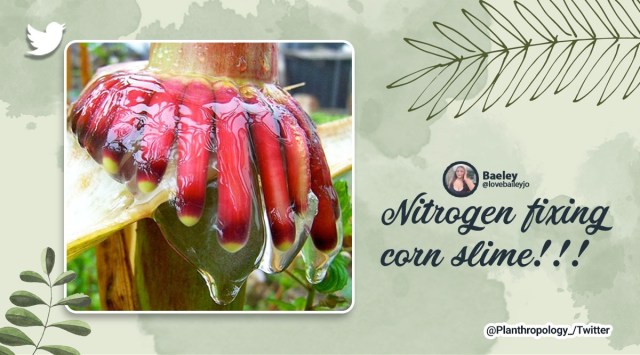‘A-maize-ing’: This corn variety from Mexico might cut use of fertilisers
The aerial roots of Sierra Mixe maize directly fertilise nitrogen from the air without any need for fertilisers.

A tweet about an indigenous variety of maize that grows in Sierra Mixe, a mountainous region in Southern Mexico, has netizens in awe of the exotic-looking crop. The tweet was posted by Planthropology Podcast (@Planthropology_) on Monday along with a photograph of the Sierra Mixe maize.
When researchers first saw the Sierra Mixe maize, they were surprised by how the crop grew up to 16 feet without the support of fertilisers. According to an article in The Atlantic in 2018, it took years of research, before scientists from the University of California, Davis, discovered that the secret of this endemic maize’s growth was its aerial roots.
Almost all plants require nitrogen to grow. They convert atmospheric nitrogen into the usable form of ammonia with the help of microbes that are lodged in their roots. However, cereal crops like rice and maize have limited nitrogen-fixing bacteria in their roots. This is why farmers use nitrogen-rich fertilisers in the soil to stimulate their growth.
As reported by British journalist Ed Yong, in the case of Sierra Mixe maize, it was discovered that the bacteria-rich aerial roots, which look like a group of mucus-covered red tubes, were directly converting nitrogen from the air into a nutritional form. This direct conversion of nitrogen did not require the locals to pump artificial fertilisers into the crop.
Since this variety of maize takes up to eight months to fully mature, it is not suited for the fast-paced world of commercial farming. Many biochemists believe that if one devises a way to expedite the growth of Sierra Mixe maize without compromising its aerial roots then the world can have a fertiliser-free variety of maize.
The post by Planthropology Podcast soon moved past its niche audience of plant enthusiasts and gathered 35,000 likes.
Hi there, to round out your weekend, you’ve officially been notified that there’s endemic Mexican maize that has aerial roots that use bacterial colonies to fix nitrogen from the atmosphere. It looks like this. You needed to know that. pic.twitter.com/CXtI5FkXus
— Planthropology Podcast🌵 (@Planthropology_) November 6, 2022
Some of my Welsh grown corn showing similar in 2018 🙂 pic.twitter.com/U1dAKiTdgr
— Chris Fowler (@ChilliFowler) November 7, 2022
a-maize-ing
— anastasia (@nebegamon) November 7, 2022
I grew maize (not that indigenous mexican sort though) successfully in Glasgow this summer and was astonished by the aerial roots. The ground root system of the plants was also significant and hard work to dig out at the end of the season.
— Dr Nina Baker (@ninabake2) November 7, 2022
Nitrogen fixing corn slime. I’m so glad I now have that phrase floating about in my head 🥰
— 🕷scienTEAfic🕷 (@tea_francis) November 7, 2022
For every weird alien or fantasy creation you come up with, mother nature has done something weirder. https://t.co/UgmUvNHxhD
— A Deep Sea PanzerLion (@POCGamer) November 7, 2022
Ah!!! Thank you for posting this! One of my neighbors has a massive front yard garden and I’ve noticed these roots on their corn.
— Stacey Gorniak, PhD, FAHA (@ProfGorniak) November 7, 2022
Commenting on the plant’s appearance, a Twitter user wrote, “Sometimes I am incredibly impressed by how strange our planet is.” Another person remarked, “For every weird alien or fantasy creation you come up with, mother nature has done something weirder.”



- 01
- 02
- 03
- 04
- 05




























